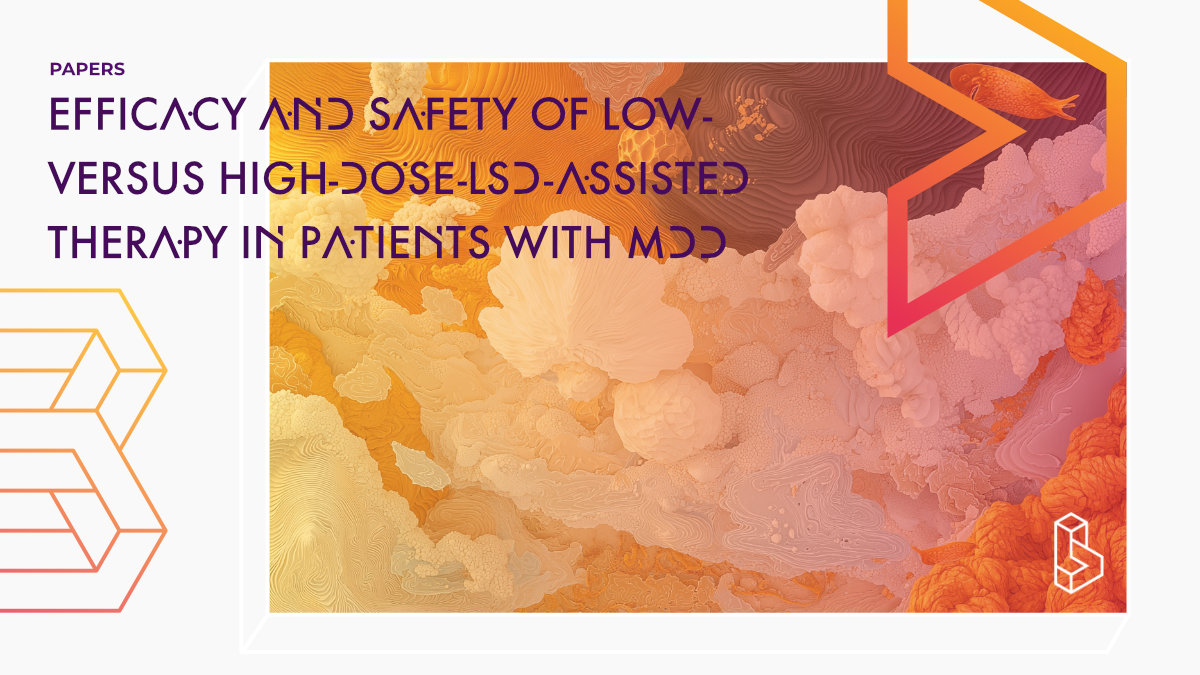This double-blind controlled trial (n=61) found that high-dose LSD-assisted therapy (100μg + 200μg) reduced depression symptoms more than low-dose LSD (25μg + 25μg) in patients with moderate-to-severe major depressive disorder (MDD), with benefits lasting up to 12 weeks and similar side effects between groups.
Abstract of Efficacy and safety of low- versus high-dose-LSD-assisted therapy in patients with major depression
“Background: This trial aimed to assess the efficacy of lysergic acid diethylamide (LSD)-assisted therapy in patients with moderate-to-severe major depressive disorder.
Methods: This was a randomized, parallel, double-blind, low-dose controlled trial (Clinicaltrials.gov: NCT03866252). Patients were randomly assigned in a 1:1 ratio to receive supportive psychotherapy and either 100 μg + 200 μg LSD or 25 μg + 25 μg LSD in two dosing sessions. The primary endpoints were the changes in scores on the Inventory of Depressive Symptomatology, in the Clinician-Rated (IDS-C) version (assessed by the treating therapist) and the Self-Rated (IDS-SR) version, from baseline to 2 weeks after the second administration. The IDS scores were also assessed 6 and 12 weeks after the second administration.
Findings: Thirty-one patients were randomized to the low-dose group, and 30 were randomized to the high-dose group. At the primary endpoint, least-squares mean change (LSM) in IDS-SR scores was −3.9 in the low-dose and −11.8 in the high-dose group (difference: −7.9; 95% CI, −16.0 to 0.3; effect size: −0.5; p = 0.059). LSM in IDS-C scores was −3.6 in the low-dose and −12.9 in the high-dose group (difference: −9.2; CI, −17.1 to −1.3; effect size: −0.6; p = 0.023; corrected <0.05). However, significance was not reached after adjusting for baseline depression scores (p = 0.086). Both outcomes remained numerically consistent up to the final follow-up at 12 weeks. Adverse events were comparable between groups.
Conclusions: The findings of this exploratory study support further investigation of LSD-assisted therapy in depression in a larger phase 3 trial.“
Authors: Felix Müller, Hannes Zaczek, Anna M. Becker, Laura Ley, Stefan Borgwardt, Joyce Santos de Jesus, Nico Loh, Jan Kohut, Mathias Auernig, Christopher Boehlke & Matthias E. Liechti
Summary of Efficacy and safety of low- versus high-dose-LSD-assisted therapy in patients with major depression
Lysergic acid diethylamide (LSD) is a hallucinogenic compound known to activate serotonin-2A receptors in the brain, leading to altered perceptions and emotional states. Early studies conducted in the 1950s and 1960s proposed that LSD could provide lasting antidepressant effects, but those investigations suffered from significant methodological flaws, such as small sample sizes and poor control conditions. More recent studies involving related psychedelic substances, such as psilocybin, have demonstrated promising results in alleviating symptoms of depression, prompting renewed interest in the therapeutic potential of LSD.
This trial was designed to rigorously evaluate LSD’s antidepressant effects in a modern clinical setting. The authors aimed to compare the outcomes of two different dosing regimens in patients with moderate-to-severe major depressive disorder (MDD). Specifically, the study assessed whether high-dose LSD therapy was more effective than a low-dose comparator, both delivered within a structured psychotherapeutic framework. The use of a low-dose active control was intended to enhance the blinding of participants and clinicians, which has been a challenge in psychedelic research due to the conspicuous subjective effects of these compounds.
Methods
Study Design
This was a Phase II, randomised, double-blind, parallel-group trial involving two LSD-assisted therapy conditions: a high-dose group receiving 100 micrograms in the first session and 200 micrograms in the second, and a low-dose group receiving 25 micrograms in both sessions. All participants also engaged in eight sessions of supportive psychotherapy, including preparatory and integration meetings. The trial spanned 19 weeks and was conducted at a psychiatric clinic in Switzerland. The design adhered to international ethical standards, and informed consent was obtained from all participants.
Find this paper
https://doi.org/10.1016/j.medj.2025.100725
Open Access | Google Scholar | Backup | 🕊
Cite this paper (APA)
Müller, F., Zaczek, H., Becker, A. M., Ley, L., Borgwardt, S., de Jesus, J. S., ... & Liechti, M. E. (2025). Efficacy and safety of low-versus high-dose-LSD-assisted therapy in patients with major depression: A randomized trial. Med.
Study details
Topics studied
Depression
Safety
Study characteristics
Original
Placebo-Controlled
Active Placebo
Double-Blind
Randomized
Participants
61
Humans
Compound Details
The psychedelics given at which dose and how many times
LSD 100 - 200μg | 2x Placebo 25 μg | 2x
Linked Clinical Trial
LSD Therapy for Persons Suffering From Major DepressionTo test the efficacy of LSD in patients with Major Depressive Disorder.

